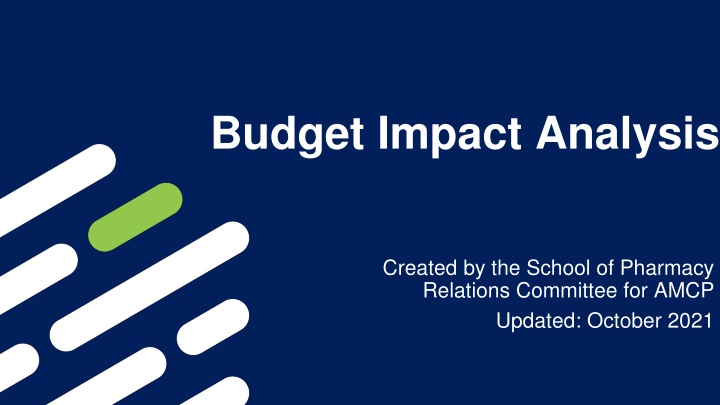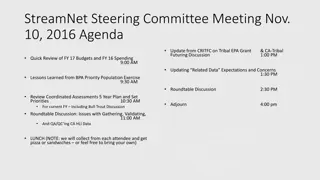Budget Impact Analysis: Essentials for Resource Planning
Dive into the key aspects of budget impact analysis (BIA) in healthcare, including its definition, purpose, differentiation from cost-effectiveness analysis, and designing considerations. Understand how BIA aids in decision-making for budget holders and payers by predicting the financial impact of new interventions within available resources.
Download Presentation

Please find below an Image/Link to download the presentation.
The content on the website is provided AS IS for your information and personal use only. It may not be sold, licensed, or shared on other websites without obtaining consent from the author.If you encounter any issues during the download, it is possible that the publisher has removed the file from their server.
You are allowed to download the files provided on this website for personal or commercial use, subject to the condition that they are used lawfully. All files are the property of their respective owners.
The content on the website is provided AS IS for your information and personal use only. It may not be sold, licensed, or shared on other websites without obtaining consent from the author.
E N D
Presentation Transcript
Budget Impact Analysis Created by the School of Pharmacy Relations Committee for AMCP Updated: October 2021
Overview Introduction to budget impact analysis (BIA) Differentiation between BIA vs. cost-effectiveness analysis (CEA) Designing BIA Considerations and models for conducting BIA Helpful resources
Introduction of BIA
Definition of BIA A budget impact analysis (BIA) is: an evidence-based analysis used to assess the financial consequences of the adoption of a new intervention, given the available budget and resources.
Purpose of BIA BIA is essential for budget and resource planning as it aids decision- making for reimbursement authorities/budget holders/payers. Formulate a short term (typically 1 to 5 years) estimate of the changes in expenditure, cost, and healthcare utilization after the adoption of a new intervention. Predict the budget impact of a new intervention in the population. Predict the characteristics of the population and the healthcare system after adoption of the new intervention.
Differentiation between BIA vs. CEA Budget impact analysis (BIA) BIA assesses the financial consequences of a new intervention given the available resources and budget. Cost-effective analysis (CEA) CEA evaluates the value of a new intervention relative to current ones. The time horizon is usually short (1 to 5 years). The time horizon is long (can be a life-time horizon). BIA estimates costs and changes in costs. CEA estimates the cost per clinical outcome, such as life years (LY) and quality-adjusted life years (QALY) gained. The results are reported in incremental cost- effectiveness ratio (ICER). The results are reported in cost per member per month (PMPM).
Identify budget holder/ perspective Identify the budget holder for whom the BIA is conducted - Is the budget holder a private payer or a regional/national healthcare system? Consider the features that influence the budget and the coverage decision - Who and what are being covered under the health system? - What are the access restrictions to reimbursement? Consider the perspective of the budget holder - Should the BIA include healthcare costs only or other societal costs (travel expenses, lost productivity, unemployment benefits, etc.)?
What is the current intervention mix? Identify the size of the total population (eg, plan size) Identify the size of the target population (all patients eligible for the new intervention) Identify the current interventions (comparators) being used and the market share of those interventions in the target population - May include no intervention, alternatives, combination therapies, and off-label drugs. - Often times nationally recognized treatment guidelines are a good source for identification of all potential comparators in a target population
Know the effect of the new intervention Identify the role of the new intervention and its effect on the current market o Substitution: the new intervention replaces the current interventions. o Combination: the new intervention is used in combination with the current interventions. o Expansion: the new intervention is an alternative option for patients who have stopped or refused available interventions for any reasons. o Supportive care: the new intervention is used in a market where no active intervention is available.
Assumptions Assumptions are often introduced when little or no data exist regarding various inputs in the model. Assumptions must be stated clearly to ensure transparency. Typical assumptions in a pharmacoeconomic study: Cost considerations Treatment mix (eg, market share) Time horizon Cycle length Time dependency variables Discount rate
Cost Considerations Direct costs: Cost in condition-related health care services; and any related diagnostic costs to identify these patients This may include costs associated with the drug and each comparator (drug costs, costs of managing side effects, administration costs, monitoring costs) Healthcare resource utilization/cost (any cost changes due to greater/fewer hospitalizations, ER visits, or outpatient visits) Indirect costs: Medical-related and non-medical related indirect costs (cost of social service, work productivity costs, and other costs) Note that indirect cost is only considered if perspective of the BIA is from society or national healthcare system.
Cost Examples Medical costs: Medications Medication monitoring Medication administration Patient counseling and consultations Diagnostic tests Hospitalizations Clinic visits Emergency department visits Home medical visits Ambulance services Nursing services Nonmedical costs: Travel costs to receive health care Nonmedical assistance related to the illness Accommodations for patient or caregiver for out-of- town care Childcare services Direct Cost Lost of productivity for patient Lost of productivity for unpaid caregiver Lost of productivity because of premature mortality Intangible costs from pain, suffering, fatigue, and anxiety Indirect Cost
Time horizon and Cycle Length Time horizon The time horizon for a BIA is directly relevant to the budget holder and is typically a short period of time (1 to 5 years). Cycle length The cycle length could be quarterly, annually, etc depending on the needs of the budget holder.
Time Dependency and Discount Rate Time dependency Time-dependent variables (value of the currency, new intervention(s), new understanding of diseases, etc.) need to be captured in a BIA. Discount rate Most budget holders are interested in the budget/costs (dollar amount) at each point in time; therefore, discounting is not recommended in conducting a BIA.
Additional Considerations
Budget Impact Model (BIM) Provide detail description of the analysis in a recommended format State all assumptions used in the model Adopt inputs and data specific to the target population and the budget holder Estimate average cost per member per month (PMPM) for the new intervention Perform scenario analysis to account for different perspectives and scenarios
Uncertainty Recognize that uncertainty may be present due to uncertainty in the input values and in introducing assumptions Uncertainties in the input values o E.g.: efficacy and safety of the interventions, population size, costs, etc. Uncertainties created by introducing assumptions o E.g.: changes in expected intervention patterns, introduction of new interventions, new restrictions for use, time to generic substitution, etc.
Sensitivity Analysis Assess the impact of assumptions made in a pharmacoeconomic study and the robustness of the data Given the uncertainty of these assumptions, it s important to understand which variables drive the biggest changes in the model to know where uncertainty might have the biggest impact on the model outcomes Tests whether the outcomes are of the same direction or of a similar magnitude when these assumptions are varied (each assumption is varied higher or lower by a set percentage) Tornado diagrams are commonly used to visually represent the impact of these variables
Validation of BIM Face validation with decision makers and verify the inputs, data, sources, and calculations.
Key Considerations Ensure accurate inputs and data from the best available sources Thoroughly cite references to enhance transparency and validity Ensure customization to fit specific needs from a budget holder Collect inputs and data from published clinical trials, published data, accredited national statistics, and data provided by the budget holder Present the outcomes in the format of interest to the budget holder Utilize visuals (e.g. budget impact curve with tolerance range) when presenting BIA
Helpful resources ISPOR: - Training courses: https://www.ispor.org/conferences-education/education- training/virtual/distance-learning/introduction-to-budget-impact-analysis-bia-part-ii - Good practice guideline: https://www.ispor.org/heor-resources/good- practices/article/principles-of-good-practice-for-budget-impact-analysis-ii NICE: - Budget impact template (.xlsx): https://www.nice.org.uk/Media/Default/About/what-we- do/our-programmes/evidence-standards-framework/budget-impact-template.xlsx - Budget impact analysis template (.docx): https://www.nice.org.uk/Media/Default/About/what- we-do/NICE-guidance/NICE-technology-appraisals/Company-budget-impact-analysis- submission.docx - (Note: the currency unit in NICE templates is in Euro ) Other sources: - VA s Health Economics Resource Center (HERC): https://www.herc.research.va.gov/include/page.asp?ID=home
References 1. Sullivan SD, Mauskopf JA, Augustovski F, Caro JJ, Lee KM, Minchin M, Orlewska E, Penna P, Barrios JM, Shau WY. Budget impact analysis principles of good practice: report of the ISPOR 2012 Budget Impact Analysis Good Practice II Task Force. Value in health. 2014 Jan 1;17(1):5-14. Anto anzas F, Terkola R, Overton PM, Shalet N, Postma M. Defining and measuring the affordability of new medicines: a systematic review. Pharmacoeconomics. 2017 Aug;35(8):777-91. Mauskopf J, Earnshaw S. A methodological review of US budget-impact models for new drugs. Pharmacoeconomics. 2016 Nov;34(11):1111-31. National Institute for Health and Care Excellence (website). Accessed on: September 18, 2021. Available at: https://www.nice.org.uk/ https://www.nice.org.uk/about/what-we-do/into-practice/audit-and-service-improvement/costing- tools https://www.herc.research.va.gov/include/page.asp?ID=home https://noahe.ca/download/budget_impact_models.pdf 2. 3. 4. 5. 6. 7.
Thank you to Anh Ho, PharmD, and AMCP SOPRC members for updating this presentation for 2021.
Mission & Vision To improve patient health by ensuring access to high-quality, cost-effective medications and other therapies.























